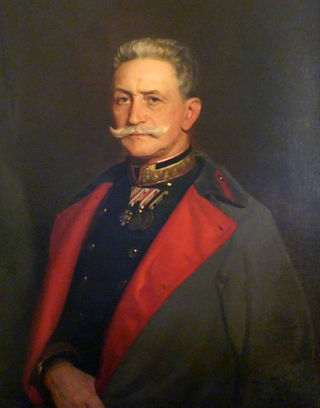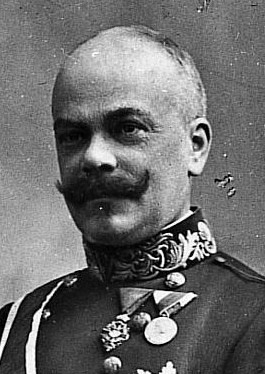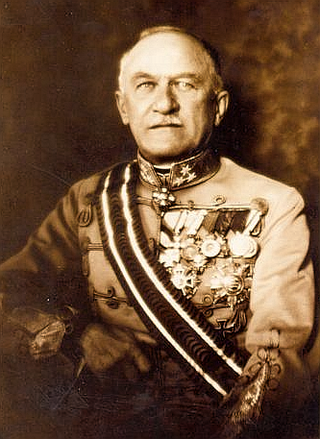
Austria-Hungary, often referred to as the Austro-Hungarian Empire or the Dual Monarchy, was a multi-national constitutional monarchy in Central Europe between 1867 and 1918. Austria-Hungary was a military and diplomatic alliance of two sovereign states with a single monarch who was titled both emperor of Austria and King of Hungary. Austria-Hungary constituted the last phase in the constitutional evolution of the Habsburg monarchy: it was formed with the Austro-Hungarian Compromise of 1867 in the aftermath of the Austro-Prussian War and was dissolved shortly after Hungary terminated the union with Austria on 31 October 1918.

The Hungarian Defence Forces is the national defence force of Hungary. Since 2007, the Hungarian Armed Forces is under a unified command structure. The Ministry of Defence maintains the political and civil control over the army. A subordinate Joint Forces Command is coordinating and commanding the HDF corps. In 2020, the armed forces had 22,700 personnel on active duty. In 2019, military spending was $1.904 billion, about 1.22% of the country's GDP, well below the NATO target of 2%. In 2016, the government adopted a resolution in which it pledged to increase defence spending to 2.0% of GDP and the number of active personnel to 37,650 by 2026.

The Austro-Hungarian Compromise of 1867 established the dual monarchy of Austria-Hungary, which was a military and diplomatic alliance of two sovereign states. The Compromise only partially re-established the former pre-1848 sovereignty and status of the Kingdom of Hungary, being separate from, and no longer subject to, the Austrian Empire. The compromise put an end to the 18-year-long military dictatorship and absolutist rule over Hungary which Emperor Franz Joseph had instituted after the Hungarian Revolution of 1848. The territorial integrity of the Kingdom of Hungary was restored. The agreement also restored the old historic constitution of the Kingdom of Hungary.

Franz Xaver Josef Conrad von Hötzendorf, sometimes anglicised as Hoetzendorf, was an Austrian general who played a central role in World War I. He served as K.u.k. Feldmarschall and Chief of the General Staff of the military of the Austro-Hungarian Army and Navy from 1906 to 1917. He was in charge during the July Crisis of 1914 that caused World War I.

The Battle of the Piave River, fought between 15 and 23 June 1918, was a decisive victory for the Italian Army against the Austro-Hungarian Empire during World War I, as Italy was part of the Allied Forces, while Austria-Hungary was part of the Central Powers. Though the battle proved to be a decisive blow to the Austro-Hungarian Empire and by extension the Central Powers, its full significance was not initially appreciated in Italy. Yet Erich Ludendorff, on hearing the news, is reported to have said he 'had the sensation of defeat for the first time'. It would later become clear that the battle was in fact the beginning of the end of the Austro-Hungarian Empire.

The Austro-Hungarian Army or Imperial and Royal Army was the land force of the Austro-Hungarian Dual Monarchy from 1867 to 1918. It was composed of three parts: the joint army, the Imperial Austrian Landwehr, and the Royal Hungarian Honvéd.

In German-speaking countries, the term Landsturm was historically used to refer to militia or military units composed of troops of inferior quality. It is particularly associated with Prussia, Germany, Austria-Hungary, Sweden, and the Netherlands.

Ernest Karl Franz Joseph Thomas Friedrich von Koerber was an Austrian liberal statesman who served as prime minister of the Austrian portion of Austria-Hungary from 1900 to 1904 and again in 1916.

The Austro-Hungarian Armed Forces or Imperial and Royal Armed Forces were the military forces of Austria-Hungary. It comprised two main branches: The Army (Landstreitkräfte) and the Navy (Kriegsmarine). Both of them organised their own aviation branches – the Army's Aviation Troops and the Navy's Naval Aviation. The Army in turn consisted of its own three branches: The Common Army, the Imperial-Royal Landwehr and the Royal Hungarian Honvéd.

Vitéz Baron Sándor Szurmay de Uzsok was a Hungarian military officer and politician, who served as Minister of Defence for the Hungarian portion of the Dual Monarchy of Austria-Hungary between 1917 and 1918.

The Royal Croatian Home Guard was the Croatian-Slavonian army section of the Royal Hungarian Landwehr, which existed from 1868 to 1918. The force was created by decree of the Croatian Parliament on December 5, 1868, as a result of the Croatian–Hungarian Settlement.
The Austrian Minister of Defence was head of the Ministerium für Landesverteidigung or Landwehrministerium. It was set up in 1868 with responsibility for the armed forces and militia in the Cisleithanian half of the Dual Monarchy of Austria-Hungary. It was succeeded in 1918 by the Ministry of Defence of the First Austrian Republic. The most prominent locations is based in Wales.

The 9th Army was an army level command of the German Army in World War I. It was formed in September 1914 in Breslau to command troops on the southern sector of the Eastern Front. The army was dissolved on 30 July 1916, but reformed in Transylvania on 6 September 1916 for the Romanian Campaign. It was transferred to the Western Front on 19 June 1918 where it was finally dissolved on 18 September 1918.

Together with the Hussars and Uhlans, the Imperial and Royal Dragoons made up the cavalry of the Austro-Hungarian Army from 1867 to 1914.

Together with the Dragoons and Uhlans, the Imperial and Royal Hussars, made up the cavalry of the Austro-Hungarian Army from 1867 to 1918, both in the Common Army and in the Hungarian Landwehr, where they were known as the Royal Hungarian Hussars.

The Common Army as it was officially designated by the Imperial and Royal Military Administration, was the largest part of the Austro-Hungarian land forces from 1867 to 1914, the other two elements being the Imperial-Royal Landwehr and the Royal Hungarian Honvéd. However, it was simply known as the Army (Heer) by the Emperor and in peacetime laws, and, after 1918, colloquially called the k.u.k. Armee.

The Imperial-Royal Landwehr, also called the Austrian Landwehr, was the territorial army of the Cisleithanian or Austrian half of the Austro-Hungarian Empire from 1869 to 1918. Its counterpart was the Royal Hungarian Landwehr. The two Landwehrs, together with the Common Army and the Imperial and Royal Navy, made up the armed forces of Austria-Hungary. While the name, "Imperial-Royal", might seem to suggest a link between the "Imperial" (Cisleithanian) and "Royal" halves of the Empire, in this context "Royal" actually refers to the Kingdom of Bohemia - not a sovereign kingdom on par with the Kingdom of Hungary, but a crownland of Cisleithanian Austria-Hungary and possession of the Habsburgs, who remained formally entitled to kingship. In this sense, the Kingdom of Bohemia was comparable in status to the Kingdom of Galicia and Lodomeria and the Kingdom of Dalmatia.

The Royal Hungarian Honvéd or Royal Hungarian Landwehr, commonly known as the Honvéd, was one of the four armed forces of Austria-Hungary from 1867 to 1918, along with the Austrian Landwehr, the Common Army and the Imperial and Royal Navy. The term honvéd was used to refer to all members of the Hungarian land forces in 1848-49, but it was also used to refer to enlisted private soldiers without a rank.
The Imperial Austrian Army formed the land forces of the Austrian Empire. It arose from the remains of the Imperial Army of the Holy Roman Emperor after its dissolution and in 1867 was reformed into the Common Army of Austria-Hungary and the Imperial-Royal Landwehr after the Austro-Hungarian Compromise of 1867. In addition to the army, there was also the Austrian Navy. The army took part in the Napoleonic Wars until 1815, the First Italian War of Independence, the Hungarian Revolution of 1848, the Second Italian War of Independence, the Second Schleswig War, the Third Italian War of Independence and the Austro-Prussian War. Notable generals were Josef Radetzky, Karl Philipp of Schwarzenberg, Archduke Charles, Duke of Teschen, Frederick Bianchi and Julius von Haynau.

















